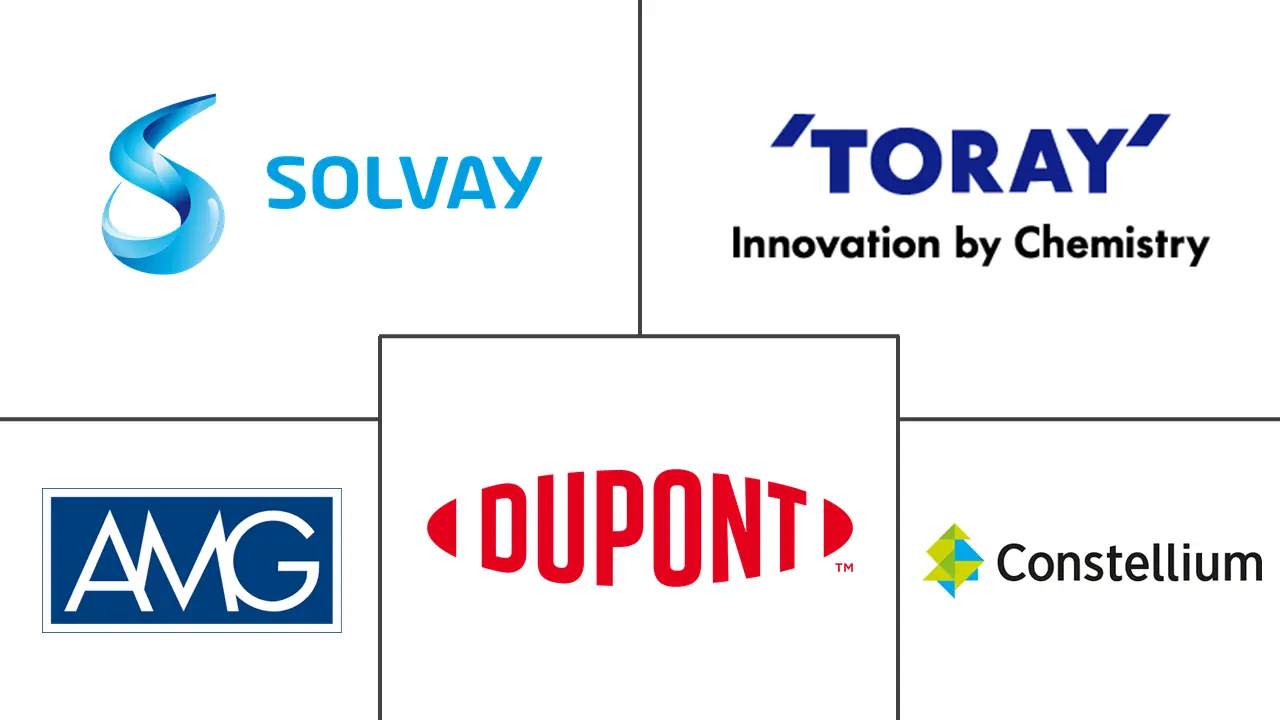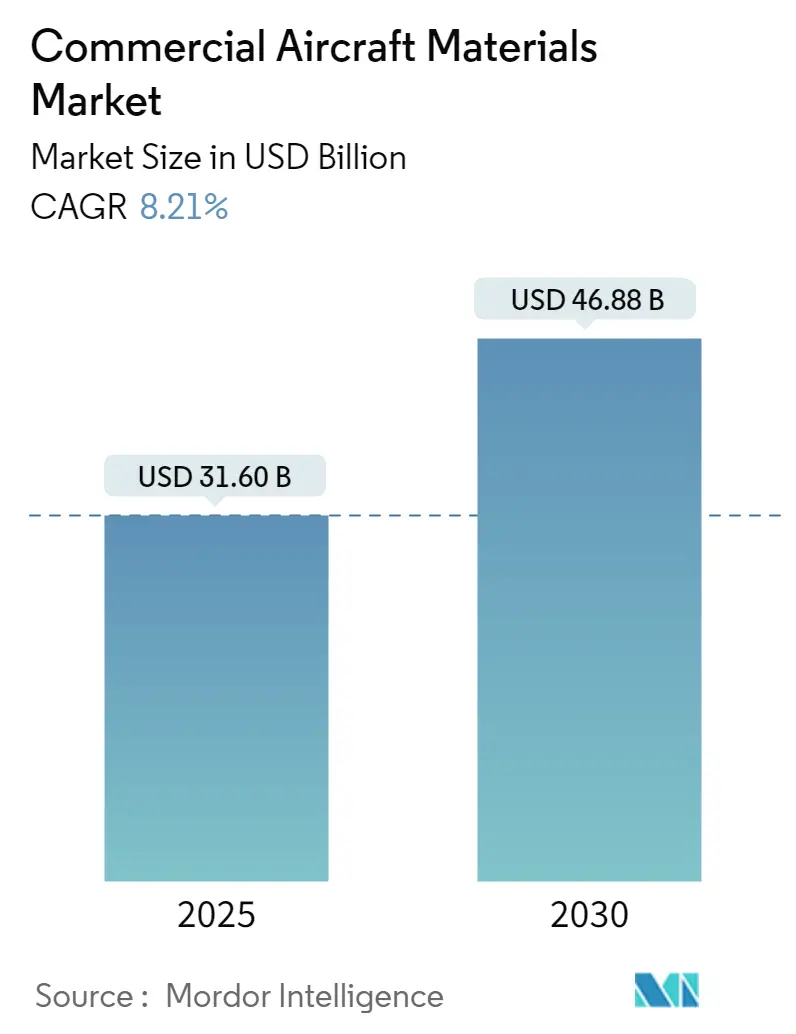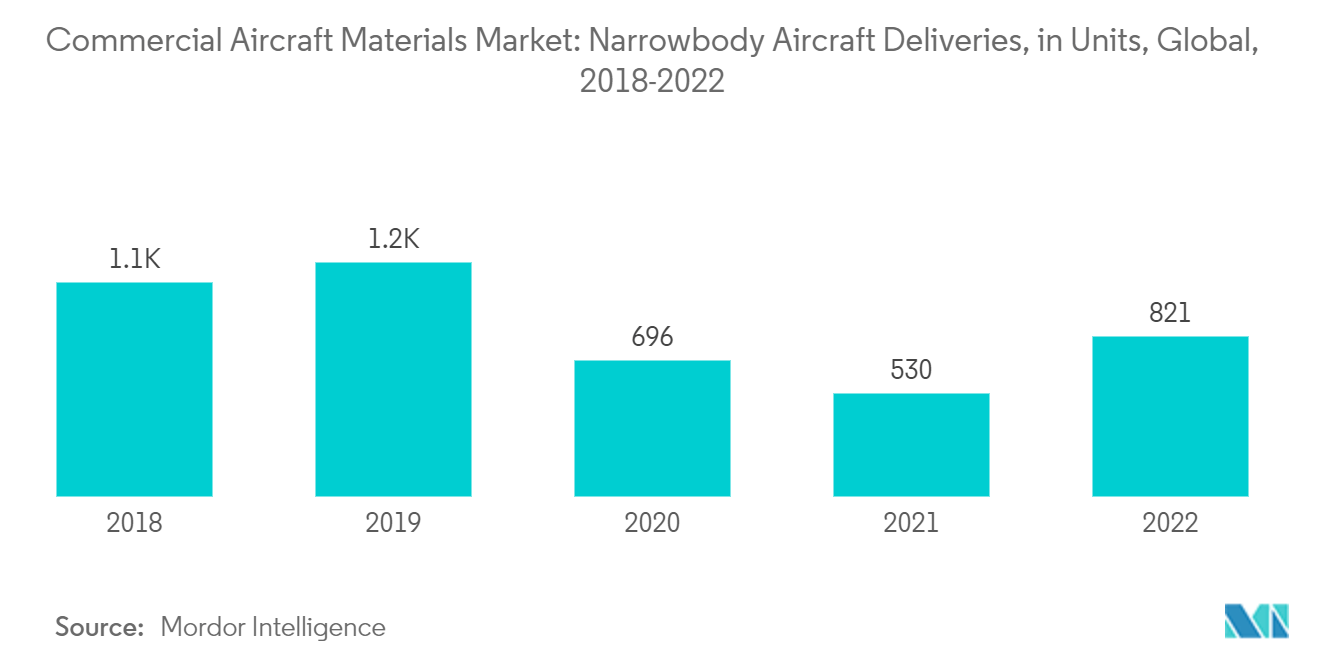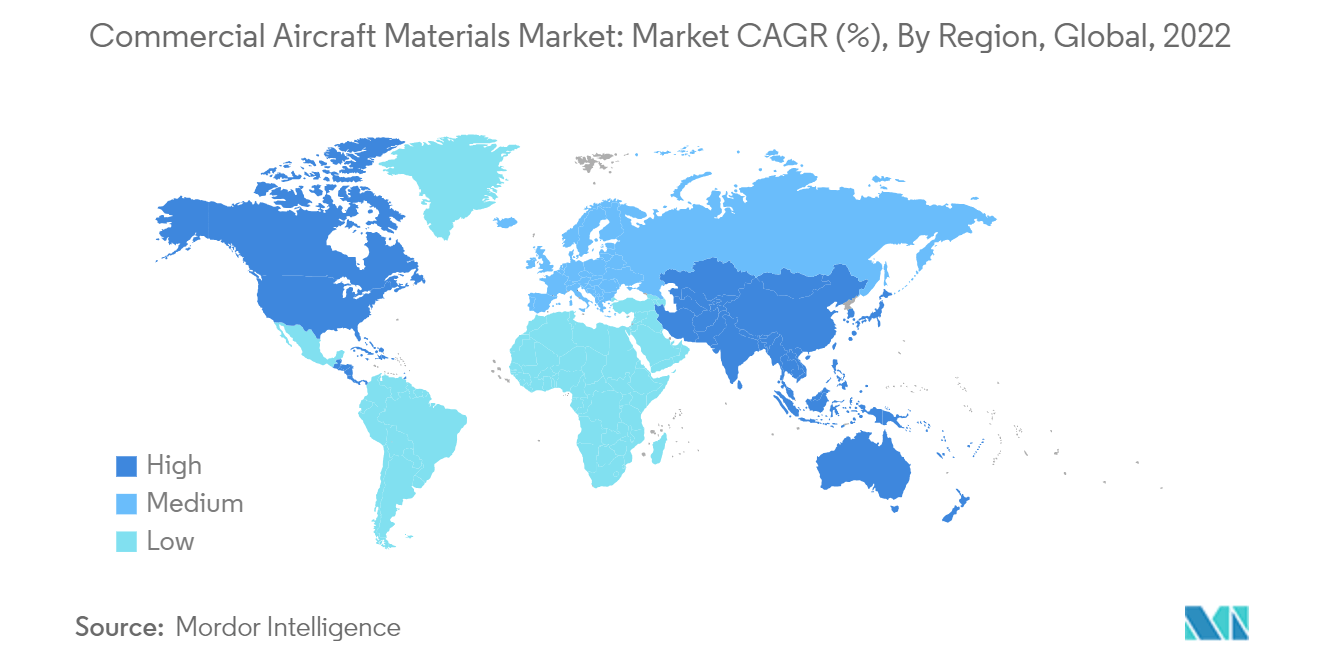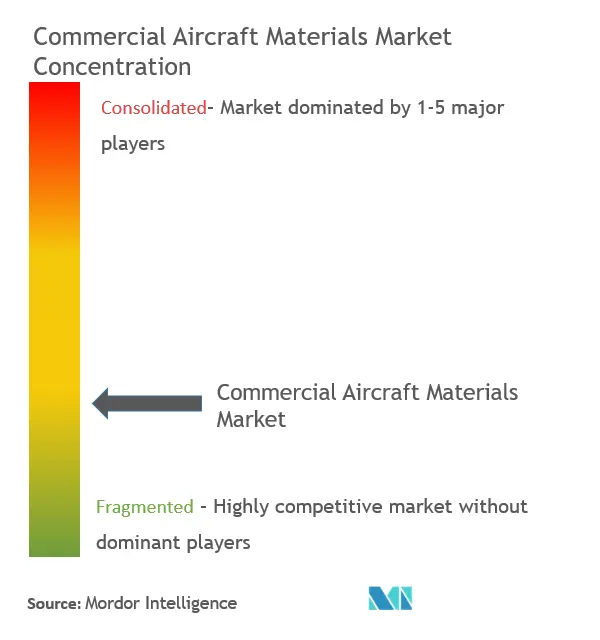Commercial Aircraft Materials Market Analysis
The Commercial Aircraft Materials Market size is estimated at USD 31.60 billion in 2025, and is expected to reach USD 46.88 billion by 2030, at a CAGR of 8.21% during the forecast period (2025-2030).
The optimal attributes for materials used in aircraft are high strength, low weight, and exceptional resistance to heat. These materials exhibit durability and possess a significant lifespan. In the past, aeronautical construction predominantly relied on titanium alloy and aluminum alloy, which comprised approximately 80% of all constituent elements.
Increasing the use of composite materials over metal alloys is expected to significantly drive the market in the future. Composites provide a high strength-to-weight ratio, high temperature, and fracture resistance over other materials, and this factor is fuelling the large-scale adoption of composites in commercial aircraft manufacturing.
The growing demand for aircraft that are both lightweight and fuel-efficient is a key factor driving the growth of the global aircraft materials market. Due to the reduced weight of the aircraft, the costs associated with operating the flights are significantly decreased, resulting in increased profitability for the aircraft operators because of improved fuel efficiency.
Commercial Aircraft Materials Market Trends
Narrow-body Aircraft Segment to Witness the Highest Growth During the Forecast Period
The narrowbody aircraft segment currently dominates the passenger aircraft category, with 80% of the global share. It is expected to continue its dominance during the forecast period due to the increase in the utilization of low-cost carriers. This factor resulted in huge demand for newer generation narrowbody aircraft, with advantages such as low cost of operation and fuel efficiency in short-haul routes.
Airline companies are shifting from widebody aircraft to narrowbody aircraft as they have become particularly doable for airlines for short-haul routes. The surge in demand for narrowbody aircraft is driving OEMs to increase their production of aircraft. Composites such as ceramic and metal matrix composites, fiber-reinforced polymers, carbon-carbon composites, etc., are used in aircraft manufacturing companies because of their favorable properties.
Several airlines are implementing fleet expansion as part of their overall strategies to enhance their route coverage and market share. For instance, in June 2023, IndiGo orders 500 Airbus A320 family aircraft. The fuel-efficient A320NEO family aircraft will allow IndiGo to maintain its strong focus on lowering operating costs and delivering fuel efficiency with high standards of reliability. During 2023-2028, around 10,000 narrowbody aircraft are expected to deliver across the globe.
North America to Continue its Dominance During the Forecast Period
The commercial aviation industry in North America has long been a significant player in the global aviation market. The demand for commercial aviation activity in the region is driven by the rising number of passengers traveling by air annually. In 2022, the region's air passenger traffic stood at 6 billion. The US accounted for the largest share which is 83%, followed by Canada, Mexico, and the Rest of North America accounted for 8%, 6%, and 2% respectively.
Furthermore, with the increasing demand for composites, companies are opening new facilities to develop advanced composites. For instance, in July 2021, Pratt & Whitney, a division of RTX, announced the inauguration of a ceramic matrix composites (CMCs) engineering & development facility in Carlsbad, the US. The facility has an area of over 60,000 square feet. It will be used for developing, integrating engineering, and low-rate production of Ceramic Matrix Composites (CMCs) for aerospace applications.
The huge order book of airlines operating in the US and Canada as a part of their fleet modernization programs is driving the demand. In May 2023, Air Canada announced that it is planning to purchase up to 20 Boeing B787 Dreamliners. Such orders for new aircraft by major airlines in the region are expected to boost the demand for aircraft materials in the coming years.
Commercial Aircraft Materials Industry Overview
The commercial aircraft materials market is fragmented due to various players providing adhesives, chemicals, composites, metals and non-metal materials, plastics, etc. Some of the prominent players in the market are Solvay SA, Toray Industries, Inc., Constellium, DuPont de Nemours, Inc., and AMG Critical Materials N.V., among others. Solvay is the major provider of composites to major aircraft programs like Airbus A220, Boeing B737, Boeing B777, Boeing B787 Dreamliner, COMAC C919, and Airbus A350. In addition to the aforementioned players, companies like General Plastics Manufacturing Company, Inc. and Alcoa Corporation provide plastic materials and metal. Alcoa Corporation provides metal and alloy products for Airbus A320, Airbus A330, Airbus A350, Boeing B737 MAX, Boeing B787 Dreamliner, and COMAC C919 aircraft programs.
The market is witnessing increased collaborations, acquisitions, and innovations in material technology, supporting the market growth. For instance, in September 2021, Hexcel Corp was awarded a multi-year contract to manufacture aerospace structures made with HexPEKK-100 material for the Boeing B777X. Under the agreement, the HexPEKK parts will be manufactured at Hexcel's additive manufacturing site near Hartford for airflow ducting applications and other supporting elements on the aircraft. Such partnerships with aircraft OEMs are expected to propel the company's growth in the coming years.
Commercial Aircraft Materials Market Leaders
-
DuPont de Nemours Inc.
-
Constellium
-
Toray Industries, Inc.
-
Solvay SA
-
AMG Critical Materials N.V.
- *Disclaimer: Major Players sorted in no particular order
Commercial Aircraft Materials Market News
In September 2022, Researchers from MISIS University in Russia put forward an innovative proposition encompassing cutting-edge technology for the development of a robust and lightweight composite material. This material, which is grounded in a polymer matrix and carbon fibers, holds the potential to be utilized in the field of aircraft construction, particularly for the fabrication of power set components and hull structures.
In March 2022, Wichita State University's National Institute for Aviation Research (NIAR) partnered with Solvay SA to develop future solutions to boost the aviation industry and generate opportunities for companies of all sizes to transfigure the future of flight at NIAR's facilities in Wichita, Kansas.
Commercial Aircraft Materials Industry Segmentation
Aircraft material refer to the materials employed in the production of aircraft components. The majority of these substances are aluminum alloys and various other metals, along with the growing importance of synthesized polymeric composites in the industry. These materials are utilized in the construction of diverse airplane constituents, such as cabin interiors, structural frameworks, propulsion systems, and others.
The commercial aircraft materials market is segmented based on aircraft type, material, and geography. By aircraft type, the market is segmented into narrow-body aircraft, wide-body aircraft, and regional jets. By material, the market is segmented into composites, aluminum alloys, steel, and other materials. The other materials segment includes adhesives, non-metal materials, and plastics, among others. The report also covers the market sizes and forecasts for the commercial aircraft materials market in major countries across different regions. For each segment, the market size is provided in terms of value (USD).
| Aircraft Type | Narrow-Body Aircraft | ||
| Wide-Body Aircraft | |||
| Regional Jets | |||
| Material | Composites | ||
| Aluminum Alloys | |||
| Steel | |||
| Other Materials | |||
| Geography | North America | United States | |
| Canada | |||
| Europe | Germany | ||
| United Kingdom | |||
| France | |||
| Russia | |||
| Rest of Europe | |||
| Asia-Pacific | China | ||
| Japan | |||
| India | |||
| South Korea | |||
| Rest of Asia-Pacific | |||
| Latin America | Brazil | ||
| Rest of Latin America | |||
| Middle-East and Africa | United Arab Emirates | ||
| Saudi Arabia | |||
| Egypt | |||
| Rest of Middle-East and Africa | |||
Commercial Aircraft Materials Market Research FAQs
How big is the Commercial Aircraft Materials Market?
The Commercial Aircraft Materials Market size is expected to reach USD 31.60 billion in 2025 and grow at a CAGR of 8.21% to reach USD 46.88 billion by 2030.
What is the current Commercial Aircraft Materials Market size?
In 2025, the Commercial Aircraft Materials Market size is expected to reach USD 31.60 billion.
Who are the key players in Commercial Aircraft Materials Market?
DuPont de Nemours Inc., Constellium, Toray Industries, Inc., Solvay SA and AMG Critical Materials N.V. are the major companies operating in the Commercial Aircraft Materials Market.
Which is the fastest growing region in Commercial Aircraft Materials Market?
Asia Pacific is estimated to grow at the highest CAGR over the forecast period (2025-2030).
Which region has the biggest share in Commercial Aircraft Materials Market?
In 2025, the North America accounts for the largest market share in Commercial Aircraft Materials Market.
What years does this Commercial Aircraft Materials Market cover, and what was the market size in 2024?
In 2024, the Commercial Aircraft Materials Market size was estimated at USD 29.01 billion. The report covers the Commercial Aircraft Materials Market historical market size for years: 2019, 2020, 2021, 2022, 2023 and 2024. The report also forecasts the Commercial Aircraft Materials Market size for years: 2025, 2026, 2027, 2028, 2029 and 2030.
Our Best Selling Reports
Commercial Aircraft Materials Industry Report
Statistics for the 2025 Commercial Aircraft Materials market share, size and revenue growth rate, created by Mordor Intelligence™ Industry Reports. Commercial Aircraft Materials analysis includes a market forecast outlook for 2025 to 2030 and historical overview. Get a sample of this industry analysis as a free report PDF download.

